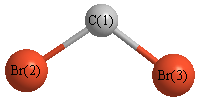Jump to
S2C1
Energy calculated at CCSD(T)/TZVP
| | hartrees |
|---|
| Energy at 0K | -5183.183973 |
| Energy at 298.15K | -5183.188953 |
| HF Energy | -5182.578138 |
| Nuclear repulsion energy | 324.015754 |
The energy at 298.15K was derived from the energy at 0K
and an integrated heat capacity that used the calculated vibrational frequencies.
Geometric Data calculated at CCSD(T)/TZVP
Point Group is C2v
Cartesians (Å)
| Atom |
x (Å) |
y (Å) |
z (Å) |
|---|
| C1 |
0.000 |
0.000 |
1.010 |
| Br2 |
0.000 |
1.562 |
-0.087 |
| Br3 |
0.000 |
-1.562 |
-0.087 |
Atom - Atom Distances (Å)
| |
C1 |
Br2 |
Br3 |
| C1 | | 1.9081 | 1.9081 |
Br2 | 1.9081 | | 3.1234 | Br3 | 1.9081 | 3.1234 | |
 More geometry information
More geometry information
Calculated Bond Angles
| atom1 |
atom2 |
atom3 |
angle |
|
atom1 |
atom2 |
atom3 |
angle |
| Br2 |
C1 |
Br3 |
109.856 |
|
Electronic energy levels
Charges, Dipole, Quadrupole and Polarizability
Jump to
S1C1
Energy calculated at CCSD(T)/TZVP
| | hartrees |
|---|
| Energy at 0K | -5183.161604 |
| Energy at 298.15K | -5183.166622 |
| HF Energy | -5182.596690 |
| Nuclear repulsion energy | 314.150411 |
The energy at 298.15K was derived from the energy at 0K
and an integrated heat capacity that used the calculated vibrational frequencies.
Geometric Data calculated at CCSD(T)/TZVP
Point Group is C2v
Cartesians (Å)
| Atom |
x (Å) |
y (Å) |
z (Å) |
|---|
| C1 |
0.000 |
0.000 |
0.730 |
| Br2 |
0.000 |
1.671 |
-0.063 |
| Br3 |
0.000 |
-1.671 |
-0.063 |
Atom - Atom Distances (Å)
| |
C1 |
Br2 |
Br3 |
| C1 | | 1.8495 | 1.8495 |
Br2 | 1.8495 | | 3.3419 | Br3 | 1.8495 | 3.3419 | |
 More geometry information
More geometry information
Electronic energy levels
Charges, Dipole, Quadrupole and Polarizability
